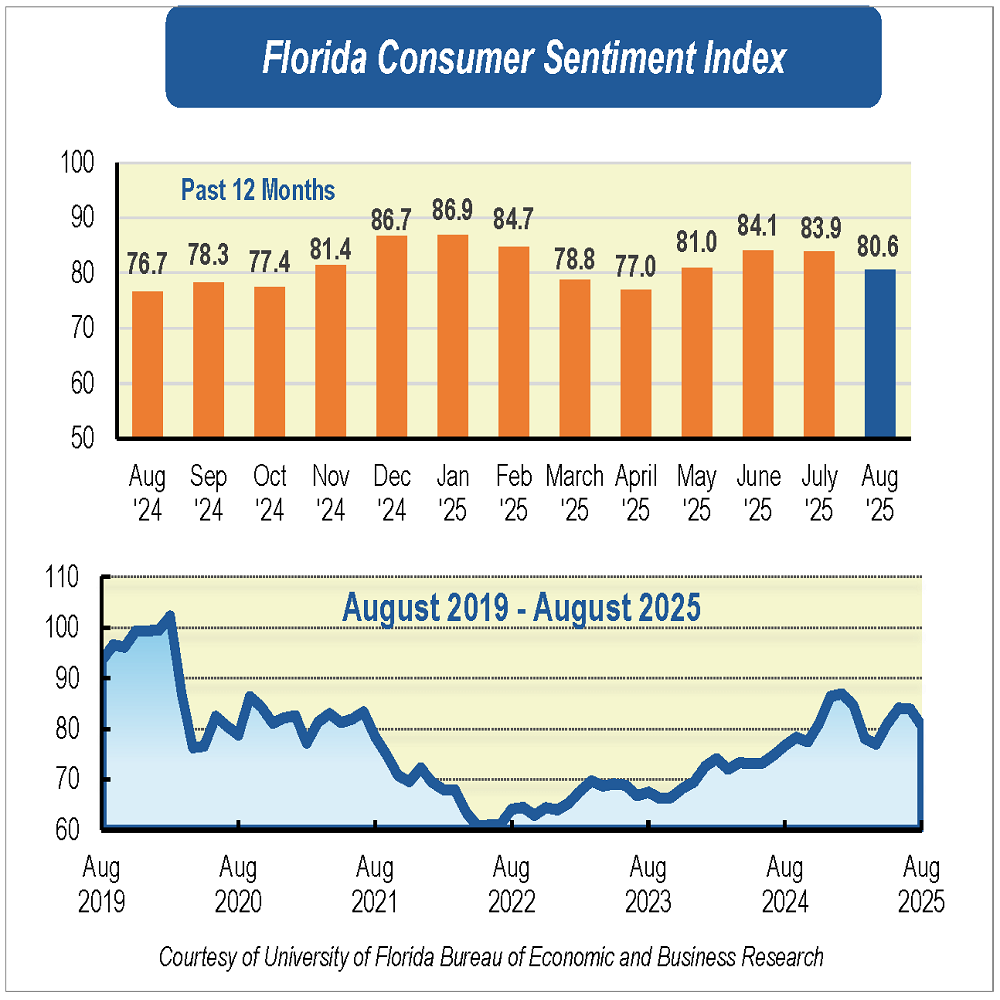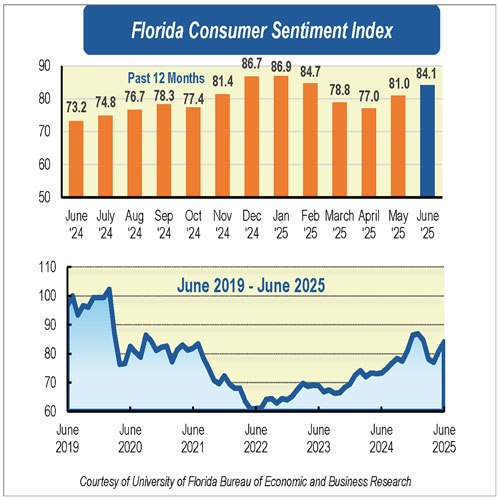National, Florida consumer confidence weakens amid economic uncertainty
Consumer sentiment in Florida declined for the third consecutive month in September, falling 1.5 points to 78.7 from a revised figure of 80.2 in August. Similarly, national sentiment declined 3.1 points.
“This month’s decline is driven primarily by reduced spending intentions and growing concerns about the national economy. While the steepest drop was in Floridians’ willingness to purchase big-ticket items, long-term expectations for the U.S. economy also fell, reaching their lowest level in 18 months. At that time, concerns focused on unexpectedly high inflation. Today, similar worries may be resurfacing, but they are now accompanied by signs of labor market weakness. This shift has prompted the Fed to respond with its first rate cut since December,” said Hector H. Sandoval, director of the Economic Analysis Program at University of Florida’s Bureau of Economic and Business Research.
Among the five components that make up the index, four declined and one remained unchanged.
Floridians’ views on current economic conditions turned more pessimistic in September. Opinions of personal financial situations compared with a year ago fell slightly 0.4 points from 71.7 to 71.3. Opinions on whether now is a good time to buy a major household item, such as an appliance or furniture, dropped sharply 4.4 points from 74.9 to 70.5, the largest decline among all components this month. These downward shifts were broadly shared across sociodemographic groups, except for women, who reported more favorable views on their personal financial situation.
Likewise, expectations about future economic conditions declined, especially regarding the national outlook. Expectations of personal financial situations a year from now remained unchanged at 87, though men, people younger than 60 and people with an annual income over $50,000 reported more negative views. Outlooks of U.S. economic conditions over the next year fell 1.2 points from 84.2 to 83, and expectations of U.S. economic conditions over the next five years declined 1.6 points from 83.3 to 81.7. However, views on the national economy were split across demographic groups, with women and people with an annual income under $50,000 reporting more optimistic expectations.
In other economic developments, the administration expanded its tariff campaign, introducing new levies on Indian goods in early September and on pharmaceuticals, trucks and kitchen cabinets later in the month, even as a federal appeals court questioned the legality of these trade measures, which remain in place pending Supreme Court review. Meanwhile, revised labor market data showed significantly fewer jobs over the past year. Although weekly jobless claims have seen sharp swings, both Florida’s and the national unemployment rates ticked up only slightly.
“Consumer sentiment remains well above the lowest levels observed in 2022, when persistent inflation weighed heavily on Floridians. Still, the current outlook is shaped by a cooling labor market, inflation that remains above target and ongoing policy uncertainty related to tariffs and the Fed’s next moves. Looking ahead, these factors may continue to weigh on sentiment, and we could see further declines in the months to come,” Sandoval said.
Conducted Aug. 1 to Sept. 25, the UF study reflects the responses of 546 individuals who were reached on cellphones and 263 individuals reached through an online panel, a total of 809 individuals, representing a demographic cross section of Florida.
Data are weighted based on Florida county of residence, age group, and sex to ensure representativeness of the Florida population. The population figures used for weighting (targets) are obtained from the Population Program of the Bureau of Economic and Business Research (BEBR), which produces the official population estimates for the state of Florida. Phone data quality is maintained by monitoring and reviewing interviews and prevention of duplicate records. Online data quality is maintained by enabling and reviewing bot and fraud detection, elimination of “short time” completes and preventing the survey from appearing in web search results.
The index used by UF researchers is benchmarked to 1966, which means a value of 100 represents the same level of confidence for that year. The lowest index possible is 2, and the highest is 150.
Details of this month’s survey can be found at bebr.ufl.edu/florida-consumer-sentiment/.



